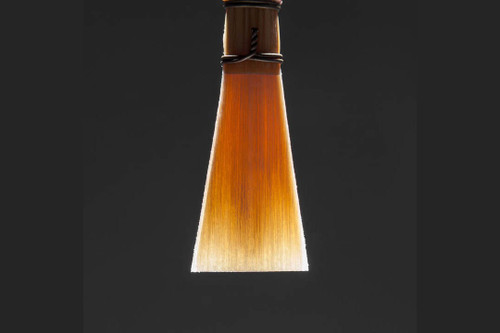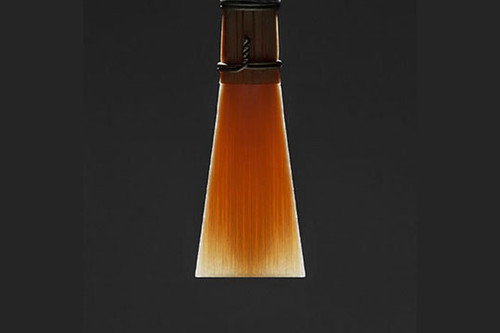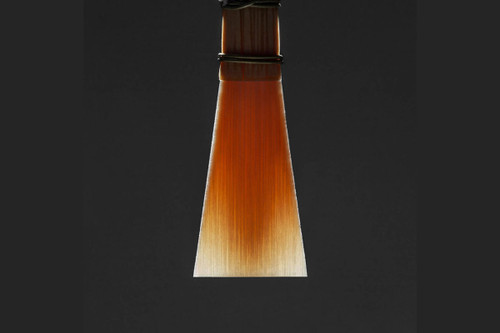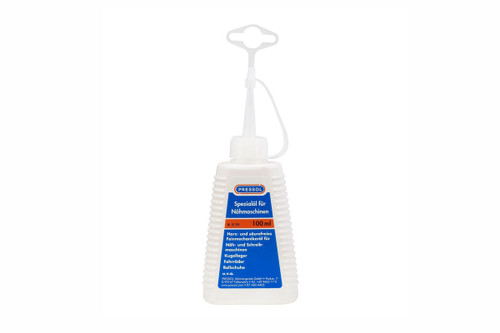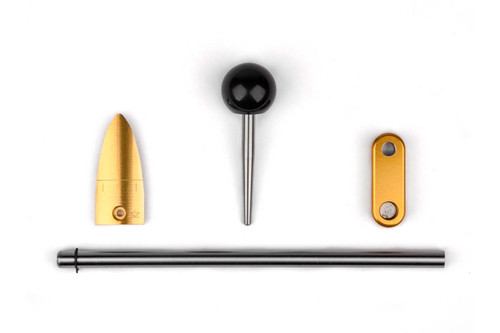Reeds 'n Stuff Bassoon Tip Profiler
The Reeds 'n Stuff Bassoon Tip Profiler is designed to remove cane off the lay of the blades of a clipped reed or a blank. The tip profiler removes wood from 1/2 to 3/4 of the reed blade, leaving the back as thick as the profiler leaves it, essentially doing a great deal of finishing of the reed except for specific choices of the reed maker to fine-tune the reed. The tube end of the reed is held on a mandrel with a black knob that is removable and has a dedicated location when not in use. An adjustment knob on top can help you customize the thickness of your finishing dimensions. A formed latch helps hold the reed in place so that it doesn't move when using the machine. The shape of your finishing profile has a plate that can be moved back a bit, but which can also be replaced with a different template. We have twelve templates in stock and you should choose one when you order the machine. The twelve choices are listed below. Also included is a locking screw that holds the mechanism in place and a hole to place the screw when using the machine. The tip profiler comes in a carrying case made of dense foam covered in stylish black nylon.
We still have some tip profilers with the old style of blade but can put the new circular blade on instead. Please make sure to select the new blade choice in the options if you want that on your machine.
Templates
ARB - Eric Arbiter's adaptation from Bernard Garfield’s and Walter Urbach's reed designs (Description written by Eric Arbiter)
"I discuss the history of this pattern in my book, The Way of Cane. Here are page numbers for other shadow photographs of this particular trim type, similar to these except they are in black and white.
Pages xxv, p. 22, p.73, 92, 111, 172-173, 235 (with thickness measurements), p. 305, Bernard Garfield’s reed.
There are so many different ways to trim the bassoon reed. This particular style is the one that works best for me and my bassoon. It’s also one of the reasons that I wrote The Way of Cane: to sketch out some of the major types of trim styles to try if looking for alternatives for directions for possible improvement.
For anyone more interested in the development and history of this pattern I outline it below.
I found the reed style that made a big difference for me with my month of lessons with Bernard Garfield during my winter term in 1969, my first year at Oberlin Conservatory. I immediately took to his reeds and began to model mine after this style. In those days, reed machines were much simpler so most of the work had to be done by hand.
Fast-forward several years later to 1974 when I started my position of Associate Principal in the Houston Symphony. During my first year, I was having problems playing 3rd bassoon (low and very softly) when the repertory required it. My bassoon was leaking a lot— or my reed making just wasn’t up to the task– but for whatever the reason, I needed help.
I read in To The World’s Bassoonists by Gerald Corey, a recommendation for reeds made by Walter Urbach, who performed in the Berlin and Nuremberg Philharmonic Orchestras, and I ordered four reeds from him, which ended up working very well for me. Coincidentally these reeds were constructed along similar lines to Mr. Garfield’s so it was a win-win for me and solved my problems until I could get my bassoon sealed properly. I continued to use both the Urbach and Garfield reeds as models for my own since that time. This new Reeds ’n Stuff template— ARB— is based on my adaptation of Mr. Garfield’s and Herr Urbach’s reed designs."
BOSA - The "BOSA" template was developed with Matthew Boice, and is consistent with the measurements of the first day scrape from "Making Reeds Start to Finish with George Sakakeeny." This template is designed to be used with the van Hoesen and SVH shapes, but can also be used with the following narrow shapes with good results: Herzberg (With 3 mm cut off of the butt of the shape), Rieger 14, Rieger 1A, Fox 1, and Fox 2. The template is designed for a reed with an overall length of 53.5 mm to 54 mm, with a 27 mm tube length. A scrape length of 15 mm is possible with this template. The center thickness is 0.21 mm at the tip.
DJ - The characteristics of the "DJ" templates relate to the predecessor template "GR5". The reeds have a soloistic sound with a good projection as well. The sides are slightly thinner and you will promptly achieve playable results. A scraping length of 20 mm is possible. The center thickness is 0.32 mm at the tip.
FG1 and FG2 - Reeds 'n Stuff's new templates for bassoon, "FG1" and "FG2", both feature a parabolic tip shape with light corners. "FG1" is characterized by a wide, full heart. "FG2" is distinguished by a narrower heart area and quite pronounced channels on the sides. Both templates are appropriate for use with popular shapes (R2, R1A, etc.) and deliver a round, warm sound. "FG1", with its sturdy design, is also suited for use with softer cane; "FG2" offers somewhat more flexibility. The center thickness is 0.31 mm at the tip.
FG3 - The "FG3" Template is similar to the PM template, but has thinner sides and light channels. This scrape produces a warm, dark sound while maintaining focus and clarity. The center thickness is 0.21 mm at the tip.
GR - For flexible and soft reeds that can be played with a variable airflow. The template "GR" is ideal for softer cane, as well as for thicker profiled cane. A scraping length up to 15 mm is possible. The center thickness is 0.30 mm at the tip.
GR5 - For reeds with a soloistic sound, that are suitable for a continuous airflow and have a good projection. The template "GR5" works great with harder cane, as well as for thinner profiled cane. A scraping length up to 15 mm is possible. The center thickness is 0.30 mm at the tip.
HER1 - The "HER1" Template was designed after the Herzberg principles and designed to pair with the Herzberg shape. The tip is characteristically thin and the sharp step has been lightly rounded, as intended. The center thickness is 0.21 mm at the tip.
LM3 - The template "LM3" has similar characteristics as the template "GR". It produces flexible and soft reeds with a good piano and can be used with soft and thicker profiled cane. The sides of the reeds remain thicker with this template than with the template "GR", especially in the front corners. This allows a thinner overall thickness for lighter reeds that will still have stable sides. A scraping length of up to 20 mm is possible. The center thickness is 0.30 mm at the tip.
PM - The "PM" template was developed with Prof. Pierre Martens of the Lübeck Conservatory. It is characterized by a parabolic tip shape with light corners and a moderately broad heart. While conceived for wider shapes (R2 or similar), it is also well suited to narrower ones. The finished bassoon reed features a round, supple sound and a great deal of flexibility. It requires a well-supported, direct air flow and is therefore especially appropriate for solo and orchestral playing as well as chamber music. It enables a large dynamic range. The center thickness is 0.34 mm at the tip.
Background Information: Prof. Martens uses an R2 shape and primarily Güner, Lavoro, and Danzi cane with hardness 15-16, gouged to approx. 1.25 mm and profiled to 0.95 – 0.60/0.55 mm. The length of his finished reeds is 56 mm, with a shaft length of 28 mm and a scrape length of 28 mm.
THOM - The "THOM" template was developed with Prof. Jörg Michael Thome of the Felix Mendelssohn Bartholdy School of Music and Theater in Leipzig. This template is characterized by its very distinct side channels, which yield reeds with excellent flexibility. The tip is parabolic with light corners; the contour of the heart is narrow. This template is particularly well suited to hard, dense cane and relatively narrow shapes (R1a, Fox 1, FB 1, etc.). The sound of the finished reed is both agreeably dark and vivid. It is balanced throughout all registers and speaks easily, offering a precise attack with little resistance in addition to flexibility. These qualities render "THOM" valuable not only for soloistic and orchestral work, but also for use with students. The center thickness is 0.34 mm at the tip.
Background Information: Prof. Thome prefers the R1A shape and generally uses hard Marca and Vic cane, gouged to 1.25 – 1.30 mm and profiled to 0.90 – 0.60 mm. The length of his finished reeds is 55.5 mm, with a shaft length of 27.5 mm and a scrape length of 28 mm.
VR1 - Viennese Style
This template was developed together with Vladimir Kacar-Hammer, founder of Vienna Reeds.
He processes his reeds by first clipping the tip to a finished length of about 28 mm. With the tip profiler set up somewhat thicker than the finished thickness, and the rotating clamp placed between the two first wires, he profiles the entire blade of the reed. He then sets the thickness of the tip profiler to its final setting and profiles the entire reed.
He recommends reed blanks with a thickness of about 0.62 - 0.64 mm at the tip and 0.98 - 1.0 mm at the collar.
This template is designed to profile the entire length of the blade.
VZ - The template VZ is based on the characteristics of the template DJ. It has however a thicker heart, which allows for a thinner overall thickness, depending on the characteristics of the cane. For reeds with a warm and dark sound, especially for dry acoustics, for example in the orchestra pit. A scraping length of 20 mm is possible. The center thickness is 0.34 mm at the tip.
Here is a table of setup measurements to help reset your tip profiling machine or set up a new template.
Reviews (1)
Write a ReviewWrite a Review

Reeds 'n Stuff
Reeds 'n Stuff Bassoon Tip Profiler
-
Game changer!
I’ve been making reeds from GSP cane for 47 years, it just bought the R&S tip profiler, this is the best investment I ever made. My reeds now come out balanced on minutes, I can cut the tip back and run it through the profiler again and again. I have experimented with different thicknesses and profile lengths… always consistent. I can make reeds for different playing situations, 1st, 2nd, solo and wide range needed for my bassoon quartet playing.





